Long ago, it was common to work samplers containing manifold Schwalm techniques and to use them as door hangings. Today, people also like to use hangings – mostly wall hangings – to show off Schwalm techniques they think most important and most interesting. There are a wide variety of such samplers.
Here are some examples (three traditional and two contemporary pieces); I will describe them in detail step by step and from left to right.
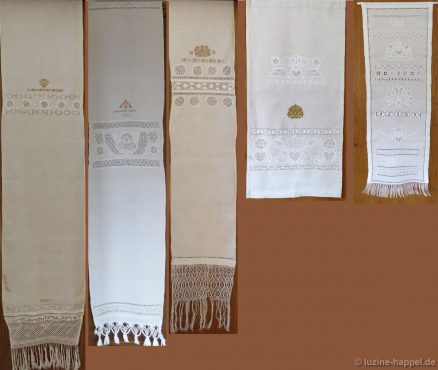
The traditional pieces are characteristically longer than the contemporary samplers. The old pieces measure about 30–40 cm in the width and 1.90–2.00 m in the height. Because people back then were not as tall as people today, I doubt these were actually used as door hangings. Regardless of whether they were hung in the door way or on the wall, they were hangings.
Also distinctive are the lace edgings found at the bottoms of the hangings.
The oldest piece of my collection – at the far left – dates back to 1801 (or possibly 1810). Its full length is not pictured – the top part is unembroidered linen.
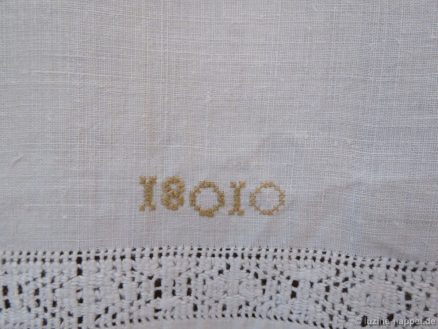
It has a needle-weaving band below the year and a Sprang lace on the bottom edge.
In the middle a small whitework border was stitched bordered by needle-weaving bands having the same patterns as the bottom band.

The whitework border includes only circle shapes that are outlined with 2 short-2 long, Blanket stitch scallops, and knife points. Small flowers worked with half-eyelet scallops, rounded leaves, and tendrils can also be seen. All motif fillings are openwork patterns; the far right motif includes the letter “G” (and possibly there is the incomplete letter “A” in the far left motif).
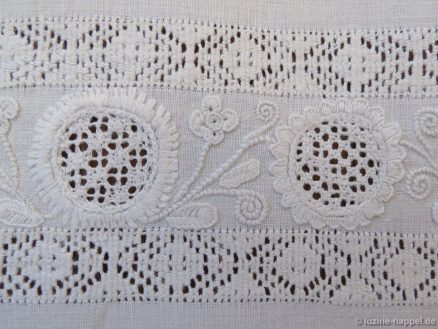
A Cross stitch crown, initials, and small rectangular ornaments complete the embroidery.
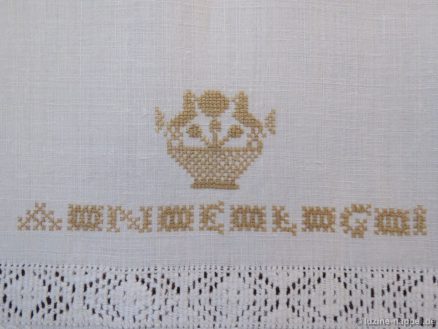
The second from the left is a small door hanging from 1845. It includes openwork bands with endless patterns. These types of openwork bands were rare in the Schwalm – openwork bands were usually decorated with figured patterns. The door hanging also includes a whitework border, initials, the year, and a Cross stitch crown stitched with two colours – again, a rarity. Detailed pictures can be seen in the article Historical Schwalm Whitework and Machine-Made Lace.
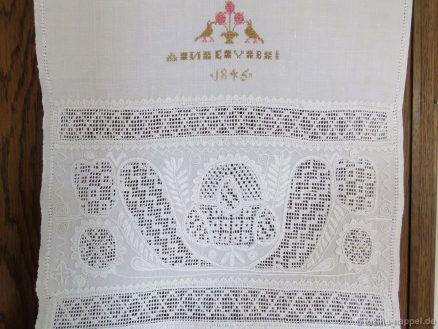
All filling patterns are openwork. Pointed Blanket stitches, rounded and pointed leaves, tendrils, curved lines, Blanket stitch eyelets (partly outlined with Eyelash stitches), and cross motifs can all be seen. The hem was secured with Four-Sided stitches.
The hanging third from the left does not include a year. It shows two small borders designed with circles and a few Coral Knot lines and tendrils. All filling patterns are openwork and the outlines are Blanket and Satin stitch scallops. Between the borders a needle-weaving band was placed. The needle-weaving section is an extra piece that was inserted between the two embroidered linen pieces.
Peaholes were worked twice – bordering the needle-weaving band and bordering the inserted section.

The hanging includes a Satin stitch crown, initials, and small Cross stitch ornaments.

At the top a small border was worked along the Peahole hem. Small circles – outlined with Satin and Blanket stitch knife points – were further embellished with openwork fillings, pointed leaves, and wide stems worked with slanting Blanket stitches. Pairs of mirrored tendrils and triple scallops alternate along a Stem stitch line.
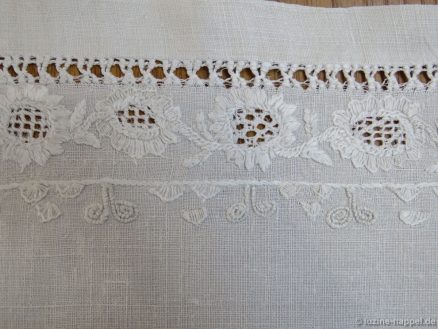
At the bottom a Sprang lace was attached.

It is interesting to see the manifold Schwalm whitework techniques of the particular era in these old pieces
I will present in detail the contemporary hangings in a future article.
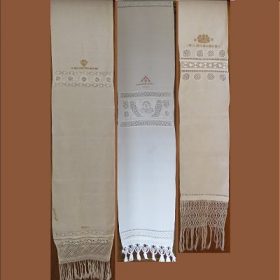


Leave a Reply